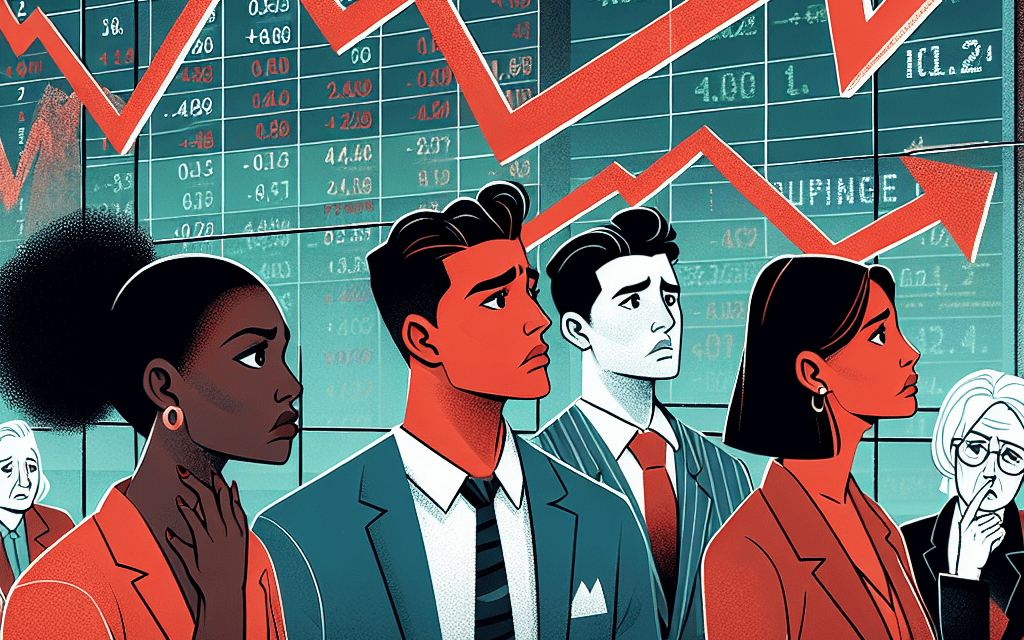“Volatile Markets: Navigating the Storm of Fed Moves and Election Jitters”
Introduction
Markets have experienced a notable decline as investors grapple with uncertainty surrounding Federal Reserve policies and upcoming elections. The financial landscape is marked by volatility, driven by concerns over potential interest rate adjustments and their impact on economic growth. Additionally, the political climate adds another layer of unpredictability, as market participants weigh the implications of electoral outcomes on fiscal policies and regulatory environments. This confluence of factors has led to heightened caution among investors, prompting a reevaluation of risk and strategy in navigating the current economic and political terrain.
Impact Of Federal Reserve Policies On Market Volatility
The financial markets have recently experienced heightened volatility, a phenomenon largely attributed to the uncertainty surrounding Federal Reserve policies and the upcoming elections. Investors are grappling with the dual challenge of anticipating the Federal Reserve’s next moves while also considering the potential implications of political shifts. This confluence of factors has created a complex environment where market participants are increasingly cautious, leading to fluctuations in stock prices and other financial instruments.
To begin with, the Federal Reserve plays a pivotal role in shaping market dynamics through its monetary policy decisions. Interest rates, in particular, are a critical tool used by the Fed to influence economic activity. When the Fed signals a potential rate hike, it often leads to increased market volatility as investors reassess their portfolios in anticipation of higher borrowing costs. Conversely, indications of rate cuts can spur optimism, driving markets upward. However, the current situation is marked by ambiguity, as the Fed has sent mixed signals regarding its future policy direction. This uncertainty has left investors in a state of flux, unsure whether to brace for tighter monetary conditions or to expect continued support for economic growth.
Moreover, the Federal Reserve’s approach to inflation is another factor contributing to market volatility. Inflationary pressures have been a significant concern, with rising prices affecting both consumers and businesses. The Fed’s response to inflation, whether through interest rate adjustments or other measures, is closely watched by market participants. Any indication that the Fed might take aggressive action to curb inflation can lead to market sell-offs, as investors fear the potential impact on corporate profits and economic growth. On the other hand, a more measured approach might reassure markets, but it also risks allowing inflation to persist, which could have long-term negative consequences.
In addition to the Federal Reserve’s policies, the looming elections add another layer of uncertainty to the markets. Political outcomes can have profound effects on economic policy, regulatory environments, and international relations, all of which are critical considerations for investors. The prospect of a change in administration or shifts in congressional power can lead to speculation about future policy directions, including tax reforms, spending priorities, and trade agreements. This speculation often results in market volatility as investors attempt to position themselves advantageously in anticipation of potential changes.
Furthermore, the interplay between Federal Reserve policies and election outcomes can create a feedback loop that exacerbates market volatility. For instance, if the Fed adopts a cautious stance due to political uncertainty, it might delay necessary policy adjustments, leading to prolonged market instability. Conversely, if political developments suggest a more stable environment, the Fed might feel more confident in implementing its policy agenda, potentially calming the markets.
In conclusion, the current market volatility is a reflection of the intricate relationship between Federal Reserve policies and election uncertainty. Investors are navigating a challenging landscape where monetary policy decisions and political developments are closely intertwined, each influencing the other. As the situation evolves, market participants will continue to monitor these factors closely, seeking clarity and stability in an environment characterized by unpredictability. Ultimately, the resolution of these uncertainties will play a crucial role in determining the future trajectory of the financial markets, underscoring the importance of both monetary and political considerations in shaping economic outcomes.
Historical Market Reactions To Election Uncertainty
Throughout history, financial markets have often exhibited heightened volatility during periods of political uncertainty, particularly in the lead-up to major elections. This phenomenon is not new, as investors grapple with the potential implications of policy shifts that could arise from a change in leadership. The anticipation of such changes can lead to market fluctuations, as traders and investors attempt to position themselves advantageously in response to the perceived risks and opportunities that a new administration might bring.
One of the most notable examples of market reactions to election uncertainty occurred during the 2000 U.S. presidential election. The contest between George W. Bush and Al Gore was marked by an extended period of uncertainty due to the controversial Florida recount. During this time, the markets experienced significant volatility, with the S&P 500 index declining by approximately 8% from the election date until the Supreme Court’s decision in mid-December. This period of uncertainty underscored the market’s sensitivity to political ambiguity and the potential for prolonged indecision to weigh heavily on investor sentiment.
Similarly, the 2016 U.S. presidential election between Donald Trump and Hillary Clinton also demonstrated the market’s responsiveness to political developments. In the months leading up to the election, markets were relatively stable, as many investors anticipated a Clinton victory, which was perceived as a continuation of existing policies. However, the unexpected outcome of a Trump victory led to an initial sharp decline in futures markets on election night. Despite this initial reaction, markets quickly rebounded, with the Dow Jones Industrial Average reaching new highs in the weeks following the election. This rapid recovery highlighted the market’s ability to adapt to new political realities, as investors recalibrated their expectations in light of anticipated policy changes under the Trump administration.
In addition to domestic elections, international political events can also influence market behavior. For instance, the 2016 Brexit referendum in the United Kingdom served as a stark reminder of how political uncertainty can impact global markets. The unexpected decision by British voters to leave the European Union led to a sharp decline in global stock markets, with the British pound plummeting to its lowest level in decades. This event illustrated the interconnectedness of global financial markets and the potential for political developments in one country to have far-reaching implications.
While historical examples provide valuable insights into how markets have reacted to election uncertainty in the past, it is important to recognize that each election cycle is unique, with its own set of circumstances and potential outcomes. Factors such as the prevailing economic environment, the candidates’ policy platforms, and the broader geopolitical landscape all play a role in shaping market reactions. Consequently, investors must remain vigilant and adaptable, as the interplay between political developments and market dynamics can be complex and multifaceted.
In conclusion, historical market reactions to election uncertainty underscore the importance of understanding the potential impact of political events on financial markets. While past experiences can offer guidance, they also highlight the need for investors to remain flexible and responsive to changing conditions. As markets continue to navigate the challenges posed by both domestic and international political developments, the lessons of history serve as a reminder of the intricate relationship between politics and market behavior.
Strategies For Investors During Economic Uncertainty
In times of economic uncertainty, such as those currently influenced by Federal Reserve policies and looming election outcomes, investors often find themselves navigating a complex landscape. The recent market declines have underscored the importance of strategic planning and adaptability in investment portfolios. As the Federal Reserve continues to adjust interest rates in response to inflationary pressures, and as political uncertainties surrounding upcoming elections create additional volatility, investors must consider a range of strategies to safeguard their assets and potentially capitalize on emerging opportunities.
One effective approach during such periods is diversification. By spreading investments across various asset classes, sectors, and geographic regions, investors can mitigate risks associated with market volatility. Diversification helps in cushioning the impact of a downturn in any single area, as losses in one sector may be offset by gains in another. For instance, while equities may experience fluctuations due to interest rate changes, bonds or commodities might offer more stability or even growth. This balanced approach can provide a more resilient portfolio that is better equipped to weather economic storms.
Moreover, maintaining a long-term perspective is crucial. Economic uncertainties, whether driven by monetary policy or political events, often lead to short-term market fluctuations. However, history has shown that markets tend to recover over time. By focusing on long-term goals and resisting the urge to make impulsive decisions based on short-term market movements, investors can avoid the pitfalls of panic selling. This disciplined approach not only helps in preserving capital but also positions investors to benefit from eventual market recoveries.
In addition to diversification and a long-term outlook, investors should also consider the role of liquidity in their portfolios. During uncertain times, having access to liquid assets can provide the flexibility needed to respond to changing market conditions. Liquid assets, such as cash or easily tradable securities, allow investors to take advantage of buying opportunities that may arise during market dips. Furthermore, liquidity can serve as a buffer against unforeseen expenses or financial emergencies, reducing the need to sell investments at inopportune times.
Another strategy involves staying informed and vigilant. Keeping abreast of economic indicators, Federal Reserve announcements, and political developments can provide valuable insights into potential market trends. By understanding the factors driving market movements, investors can make more informed decisions and adjust their strategies accordingly. Engaging with financial advisors or utilizing investment research tools can further enhance an investor’s ability to navigate uncertain markets effectively.
Finally, it is essential for investors to assess their risk tolerance and adjust their portfolios accordingly. Economic uncertainty often brings heightened volatility, which may not align with every investor’s comfort level. By evaluating their risk appetite and aligning their investment strategies with their financial goals and timelines, investors can create a portfolio that reflects their individual circumstances and preferences. This personalized approach not only enhances the potential for achieving desired outcomes but also contributes to greater peace of mind during turbulent times.
In conclusion, while market declines amid Federal Reserve and election uncertainties present challenges, they also offer opportunities for strategic investors. By embracing diversification, maintaining a long-term perspective, ensuring liquidity, staying informed, and aligning investments with personal risk tolerance, investors can navigate these uncertain times with greater confidence and resilience. As the economic landscape continues to evolve, these strategies will remain vital in helping investors achieve their financial objectives.
The Role Of Interest Rates In Market Declines

In recent months, financial markets have experienced notable declines, a phenomenon largely attributed to the dual uncertainties surrounding Federal Reserve policies and upcoming elections. Central to understanding these market fluctuations is the role of interest rates, which serve as a critical lever in the broader economic landscape. Interest rates, set by the Federal Reserve, influence borrowing costs, consumer spending, and business investment, thereby impacting overall economic growth. When the Federal Reserve signals potential changes in interest rates, markets often react with heightened volatility, as investors reassess their portfolios in anticipation of shifts in economic conditions.
The Federal Reserve’s monetary policy, particularly its stance on interest rates, is a key determinant of market sentiment. In periods of economic uncertainty, the Fed may choose to adjust interest rates to either stimulate growth or curb inflation. For instance, in an effort to combat inflationary pressures, the Fed might raise interest rates, making borrowing more expensive. This, in turn, can lead to reduced consumer spending and business investment, potentially slowing economic growth. Consequently, higher interest rates can result in lower corporate earnings projections, prompting investors to reevaluate the attractiveness of equities, which often leads to market declines.
Moreover, the anticipation of interest rate changes can be just as impactful as the changes themselves. Investors closely monitor Federal Reserve meetings and statements for any indications of future policy shifts. Even subtle hints of a rate hike can trigger significant market reactions, as investors adjust their expectations and strategies accordingly. This sensitivity to interest rate signals underscores the profound influence that monetary policy exerts on market dynamics.
In addition to the Federal Reserve’s actions, the looming uncertainty of elections further compounds market volatility. Elections introduce an element of unpredictability, as changes in political leadership can lead to shifts in economic policy. Investors often grapple with the potential implications of new fiscal policies, regulatory changes, and international trade agreements that may arise from a change in administration. This uncertainty can lead to cautious behavior among investors, who may choose to reduce their exposure to riskier assets until a clearer picture of the political landscape emerges.
The interplay between interest rates and election uncertainty creates a complex environment for investors. On one hand, the prospect of rising interest rates can dampen market enthusiasm, as higher borrowing costs weigh on corporate profitability and consumer spending. On the other hand, the unpredictability of election outcomes can exacerbate market jitters, as investors brace for potential policy shifts that could impact various sectors differently. This dual uncertainty often results in increased market volatility, as investors navigate the challenges of an evolving economic and political landscape.
In conclusion, the recent market declines can be largely attributed to the uncertainties surrounding Federal Reserve interest rate policies and upcoming elections. Interest rates play a pivotal role in shaping market dynamics, influencing everything from consumer behavior to corporate investment decisions. As investors contend with the dual challenges of monetary policy shifts and political unpredictability, market volatility is likely to persist. Understanding the intricate relationship between interest rates and market behavior is essential for investors seeking to navigate these turbulent times. By closely monitoring Federal Reserve signals and election developments, investors can better position themselves to respond to the evolving economic landscape.
Comparing Current Market Trends With Past Election Years
As the financial markets navigate the turbulent waters of 2023, investors find themselves grappling with a familiar yet complex set of challenges. The current market decline, driven by uncertainty surrounding Federal Reserve policies and the upcoming election, echoes patterns observed in previous election years. By examining these historical trends, we can gain valuable insights into the potential trajectory of the markets and the factors that may influence investor sentiment in the coming months.
Historically, election years have been characterized by heightened volatility as market participants attempt to anticipate the economic policies of potential new administrations. This uncertainty often leads to cautious trading behavior, with investors hesitant to make significant moves until the political landscape becomes clearer. In 2023, this pattern is further complicated by the Federal Reserve’s ongoing efforts to manage inflation and stabilize the economy. The Fed’s decisions regarding interest rates and monetary policy have a profound impact on market dynamics, and any indication of a shift in strategy can trigger significant market reactions.
Comparing the current situation to past election years, we observe that markets often experience a period of heightened volatility in the months leading up to the election. For instance, during the 2016 election, markets were notably volatile as investors weighed the potential implications of a Trump or Clinton presidency. Similarly, in 2020, the uncertainty surrounding the election outcome, compounded by the COVID-19 pandemic, led to significant market fluctuations. In both cases, markets eventually stabilized post-election as investors gained clarity on the policy direction of the new administration.
In 2023, the interplay between Federal Reserve policies and election uncertainty is particularly pronounced. The Fed’s commitment to curbing inflation through interest rate adjustments has created a challenging environment for equities, as higher rates typically lead to increased borrowing costs and reduced corporate profits. This, in turn, can dampen investor enthusiasm and contribute to market declines. Moreover, the Fed’s communication strategy plays a crucial role in shaping market expectations. Any perceived ambiguity or inconsistency in messaging can exacerbate market volatility, as investors struggle to interpret the central bank’s intentions.
Furthermore, the current geopolitical landscape adds another layer of complexity to market dynamics. Global events, such as trade tensions and conflicts, can influence investor sentiment and contribute to market instability. In past election years, geopolitical factors have often intersected with domestic political uncertainty, creating a challenging environment for investors. In 2023, the interconnectedness of global markets means that developments abroad can have immediate and significant impacts on domestic financial markets.
Despite these challenges, it is important to recognize that markets have historically demonstrated resilience in the face of uncertainty. While short-term volatility is a common feature of election years, long-term investors often benefit from maintaining a disciplined approach and focusing on fundamental economic indicators. Diversification and risk management strategies can help mitigate the impact of market fluctuations and position investors to capitalize on opportunities as they arise.
In conclusion, the current market decline amid Fed and election uncertainty is not an unprecedented phenomenon. By examining historical trends, we can better understand the factors driving market behavior and develop strategies to navigate this complex environment. As the election approaches and the Federal Reserve continues to refine its policies, investors will need to remain vigilant and adaptable, drawing on lessons from the past to inform their decisions in the present.
How Political Uncertainty Affects Global Markets
Political uncertainty has long been a significant factor influencing global markets, and the current climate is no exception. As the Federal Reserve’s monetary policy decisions loom large and the upcoming elections add another layer of unpredictability, investors worldwide are grappling with heightened volatility. This confluence of factors underscores the intricate relationship between political events and market dynamics, highlighting the need for investors to remain vigilant and adaptable.
To begin with, the Federal Reserve’s role in shaping economic policy cannot be overstated. Its decisions on interest rates and monetary policy have far-reaching implications for both domestic and international markets. When the Fed signals potential changes in its policy stance, such as adjusting interest rates or altering its asset purchase programs, markets often react swiftly. Investors, seeking to anticipate the impact of these changes on economic growth and inflation, may adjust their portfolios accordingly. This can lead to fluctuations in stock prices, bond yields, and currency values, as market participants reassess their risk exposure and investment strategies.
Moreover, the uncertainty surrounding the Federal Reserve’s next moves is compounded by the political landscape, particularly in the context of upcoming elections. Elections inherently introduce a degree of unpredictability, as shifts in political power can lead to changes in fiscal policy, regulatory frameworks, and international relations. These potential changes can have profound effects on various sectors of the economy, influencing investor sentiment and market performance. For instance, the prospect of a new administration with different policy priorities can lead to speculation about future tax policies, government spending, and trade agreements, all of which can sway market behavior.
In addition to domestic political factors, global markets are also sensitive to international political developments. Geopolitical tensions, trade negotiations, and diplomatic relations between major economies can create ripple effects across financial markets. For example, trade disputes between large economies can disrupt supply chains, impact corporate earnings, and alter the competitive landscape for businesses. Consequently, investors must navigate these complexities, often seeking safe-haven assets or diversifying their portfolios to mitigate potential risks.
Furthermore, the interplay between political uncertainty and market volatility is not limited to short-term fluctuations. Prolonged periods of uncertainty can have lasting effects on investor confidence and economic growth. Businesses may delay investment decisions, consumers might reduce spending, and financial institutions could tighten lending standards, all of which can contribute to slower economic activity. In such an environment, market participants may adopt a more cautious approach, prioritizing capital preservation over aggressive growth strategies.
In conclusion, political uncertainty, whether stemming from domestic elections or international developments, plays a crucial role in shaping global market dynamics. The current environment, characterized by the dual challenges of Federal Reserve policy decisions and electoral uncertainty, serves as a reminder of the intricate connections between politics and markets. As investors navigate this landscape, they must remain attuned to the evolving political and economic conditions, employing strategies that balance risk and opportunity. By understanding the potential implications of political events, market participants can better position themselves to weather the inevitable ebbs and flows of global financial markets.
Navigating Stock Market Fluctuations In Uncertain Times
In recent months, the stock market has experienced significant fluctuations, driven by a combination of factors that have left investors grappling with uncertainty. Chief among these are the Federal Reserve’s monetary policy decisions and the looming specter of upcoming elections. As these elements intertwine, they create a complex landscape that requires careful navigation by market participants.
The Federal Reserve plays a pivotal role in shaping market sentiment, and its actions are closely scrutinized by investors. In an effort to combat inflation and stabilize the economy, the Fed has been adjusting interest rates, a move that invariably impacts stock market performance. Higher interest rates tend to increase borrowing costs for companies, which can lead to reduced corporate profits and, consequently, lower stock prices. Moreover, as interest rates rise, fixed-income investments such as bonds become more attractive, potentially drawing capital away from equities. This shift in investment preferences can exacerbate market volatility, as investors reassess their portfolios in response to changing economic conditions.
Simultaneously, the political landscape adds another layer of complexity to the market environment. With elections on the horizon, uncertainty surrounding potential policy changes can lead to heightened market volatility. Investors are keenly aware that different political outcomes could result in varying fiscal policies, regulatory changes, and international trade agreements, all of which have the potential to impact corporate earnings and economic growth. As a result, market participants often adopt a cautious approach, leading to fluctuations in stock prices as they attempt to anticipate and react to potential shifts in the political landscape.
In navigating these uncertain times, investors must employ strategies that account for both the economic and political factors at play. Diversification remains a key principle, as spreading investments across various asset classes can help mitigate risk. By holding a mix of stocks, bonds, and other securities, investors can reduce their exposure to any single market event or economic development. Additionally, maintaining a long-term perspective can be beneficial, as it allows investors to ride out short-term volatility and focus on the underlying fundamentals of their investments.
Furthermore, staying informed about economic indicators and political developments is crucial for making informed investment decisions. By keeping abreast of Federal Reserve announcements, economic data releases, and political news, investors can better anticipate potential market movements and adjust their strategies accordingly. This proactive approach can help investors remain agile in the face of uncertainty, enabling them to capitalize on opportunities as they arise.
In conclusion, the current market environment, characterized by Federal Reserve actions and election-related uncertainties, presents challenges for investors. However, by employing sound investment strategies and staying informed, market participants can navigate these fluctuations with greater confidence. While uncertainty is an inherent aspect of investing, understanding the factors driving market movements and maintaining a disciplined approach can help investors achieve their financial goals, even in the most unpredictable of times. As the landscape continues to evolve, adaptability and vigilance will remain essential tools for those seeking to successfully navigate the complexities of the stock market.
Q&A
1. **What are the main factors causing market declines?**
Market declines are primarily driven by uncertainty surrounding Federal Reserve policies and upcoming elections.
2. **How does Federal Reserve uncertainty impact markets?**
Uncertainty about the Federal Reserve’s interest rate decisions can lead to market volatility as investors adjust their expectations for economic growth and inflation.
3. **In what ways do elections contribute to market uncertainty?**
Elections can create uncertainty due to potential changes in government policies, regulations, and fiscal strategies, which can affect business environments and investor confidence.
4. **Which sectors are most affected by these uncertainties?**
Financials, technology, and consumer discretionary sectors are often most affected due to their sensitivity to interest rates and policy changes.
5. **How do investors typically respond to such uncertainties?**
Investors may adopt a risk-averse approach, shifting towards safer assets like bonds or gold, and reducing exposure to equities.
6. **What historical trends are observed during similar periods of uncertainty?**
Historically, markets tend to experience increased volatility and potential declines during periods of significant political or economic uncertainty.
7. **What strategies can investors use to mitigate risks during these times?**
Diversification, maintaining a long-term perspective, and focusing on fundamentally strong companies can help mitigate risks during uncertain times.
Conclusion
The recent decline in markets can be attributed to a combination of uncertainty surrounding Federal Reserve policies and upcoming elections. Investors are grappling with the potential for interest rate adjustments by the Fed, which could impact borrowing costs and economic growth. Additionally, the political landscape is adding to the volatility, as elections often bring policy shifts that can affect market stability. This dual uncertainty is causing investors to adopt a cautious approach, leading to decreased market confidence and increased volatility. As these factors continue to unfold, markets are likely to remain sensitive to any developments, underscoring the need for strategic risk management and careful monitoring of both economic indicators and political events.





